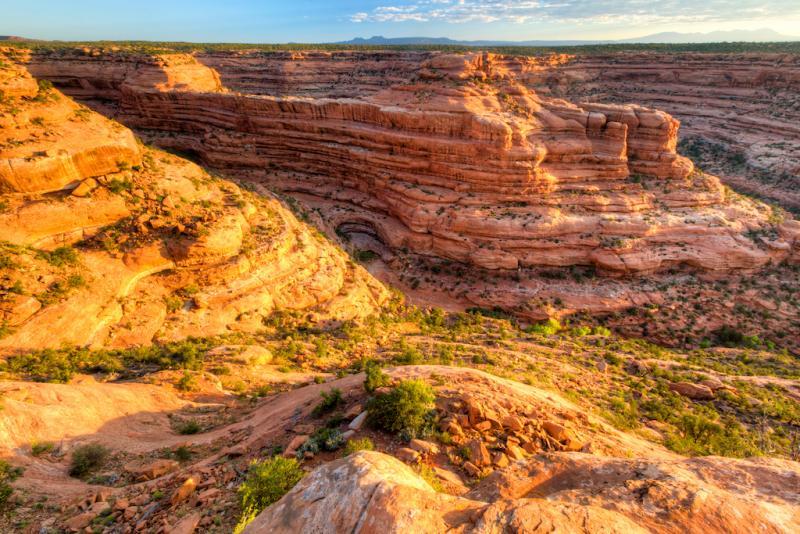
President Biden's Interior Department has been asked to review changes to national monuments -- including Bears Ears National Monument -- made by President Trump/BLM file
President Biden plans to have his Interior Department review boundary changes the Trump administration made to Bears Ears and Grand Staircase-Escalante national monuments in Utah, and its opening of commercial fishing in the Northeast Canyon and Seamounts National Monument off Cape Cod.
The reviews were anticipated, and conservation groups lobbied for them.
“We are encouraged to see President Biden respect Indigenous sovereignty, prioritize climate action, and review the gutting of protections for national monuments issued under Trump. Rightfully restoring Bears Ears and Grand Staircase-Escalante National Monuments would preserve Tribal history and culture, rich biodiversity, and be a profound step forward for our communities and climate,” said Carly Ferro, director of the Sierra Club's Utah Chapter. “In Utah, we look forward to working with the Biden administration to help restore national monument protections, prioritize tribal consultation and management, and make land conservation a part of the climate solution.”
Jacob Stern, deputy director of the Sierra Club’s Massachusetts Chapter, said the new administration's decision to look at the Northeast Canyons and Seamounts action taken by Trump "is a promising first step in our fight against the overlapping climate and extinction crises. Restoring the marine monument will benefit Massachusetts’ coastal communities, local economies dependent on healthy waters, and provide a lifeline for our diminishing ocean life and endangered deep-water coral.”
Bears Ears, a 1.35-million-acre rugged redrock landscape rich in Native American history and lore, was declared a national monument by President Barack Obama in December 2016. The crooked boundary of the monument touched Glen Canyon National Recreation Area, Canyonlands National Park, and Natural Bridges National Monument.
Grand Staircase, meanwhile, was established by President Bill Clinton in September 1996 when he set aside 1.9 million acres in southern Utah. The monument is extremely rich in paleontological resources, with nearly 150 scientists later saying the monument “hosts one of the highest concentrations of dinosaur fossils in the world,” and that only 6 percent has been surveyed, and that “the potential for future discovery is tremendous.”
In 2017 Trump tossed aside the actions Clinton and Obama took under The Antiquities Act and cut Grand Staircase by a bit more than 1 million acres and broke it into three monuments known as Grand Staircase, Escalante Canyons, and Kaiparowits. Bears Ears National Monument shrank to a bit more than 201,000 acres in the Indian Creek and Shash Jáa units from its original size of 1.3 million acres.
The reduction of the two national monuments represents the largest reduction of any protected area in the United States, according to a study that came out earlier this past fall.
While the U.S. Bureau of Land Management has developed new management plans for Bears Ears and Grand Staircase-Escalante to match President Trump's boundary changes, the legality of those changes continues to be the focus of litigation in federal courts.
President Trump last June went to Bangor, Maine, to remove a "no fishing sign" from the Northeast Canyons and Seamounts National Monument, a move hailed by the fishing industry but which drew criticisms from environmental organizations and political opponents concerned about his attacks on public lands and the environment.
The national monument encompasses a biologically robust area located about 100 miles southeast of Cape Cod National Seashore. It became the Atlantic Ocean's first national monument when Obama established it.
According to the NOAA Fisheries, the nearly 5,000 square-mile monument "includes two distinct areas, one that covers three canyons and one that covers four seamounts. These undersea canyons and seamounts contain fragile and largely pristine deep marine ecosystems and rich biodiversity, including important deep sea corals, endangered whales and sea turtles, other marine mammals and numerous fish species."
The commercial fishing industry had challenged Obama's designation in court, but the judge ruled that the former president acted within his authority under the Antiquities Act in designating the monument.
When Obama designated the monument, then-Interior Secretary Sally Jewell said the designation would "help protect the unique geology and biodiversity of these important underwater features and wildlife species that cannot be found anywhere else in the world. This critical marine area, which serves as important habitat for pelagic fish species, corals, whales, sea turtles, sea birds and other species, will now be protected and preserved for future generations, serving as an important natural laboratory for research and enhanced understanding of the impacts of climate change on our oceans.”
But in 2017, then-Interior Secretary Ryan Zinke, after a review of national monuments designated by Presidents Clinton, George W. Bush, and Obama, recommended that commercial fishing be allowed in Northeast Canyons and Seamounts National Monument.



Comments
Good news!